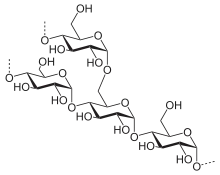Floridean starch
Floridean starch is a type of a storage glucan found in glaucophytes and in red algae (or rhodophytes), in which it is usually the primary sink for fixed carbon from photosynthesis. It is found in grains or granules in the cell's cytoplasm and is composed of an α-linked glucose polymer with a degree of branching intermediate between amylopectin and glycogen, though more similar to the former. The polymers that make up floridean starch are sometimes referred to as "semi-amylopectin".[1]

Properties
Floridean starch consists of a polymer of glucose molecules connected primarily by α(1,4) linkages, with occasional branch points using α(1,6) linkages. It differs from other common α-linked glucose polymers in the frequency and position of the branches, which gives rise to different physical properties. The structure of floridean starch polymers is most similar to amylopectin and is sometimes described as "semi-amylopectin". Floridean starch is often described in contrast to starch (a mixture of amylopectin and amylose) and glycogen:[1]
| Floridean starch | Starch | Glycogen | |
|---|---|---|---|
| Organisms | Red algae, glaucophytes | Green algae, plants | Some bacteria, some archaea, fungi, animals |
| Composition | Semi-amylopectin; classically without amylose, though some examples exist with amylose present | Amylopectin and amylose | Glycogen |
| Storage location | In the cytosol | Inside plastids | In the cytosol |
| Building block | UDP-glucose | ADP-glucose | Eukaryotes: UDP-glucose
Bacteria: ADP-glucose |
| Branching | Intermediate level of branching | Amylopectin: Branches are relatively rare and occur in clusters
Amylose: Almost entirely linear |
Branches are relatively frequent and evenly distributed |
| Genes required for maintenance | Fewer than 12 | 30–40 | 6–12 |
Historically, floridean starch has been described as lacking amylose. However, amylose has been identified as a component of floridean starch granules in some cases, particularly in unicellular red algae.[2][3]
Evolution
Features such as UDP-glucose building blocks and cytosolic storage differentiate the Archaeplastida into two groups: the rhodophytes and glaucophytes, which use floridean starch, and the green algae and plants (Chloroplastida), which use amylopectin and amylose. There is strong phylogenomic evidence that the Archaeplastida are monophyletic and originate from a single primary endosymbiosis event involving a heterotrophic eukaryote and a photosynthetic cyanobacterium.[1][4]
Evidence indicates that both ancestors would have had established mechanisms for carbon storage. Based on review of the genetic complement of modern plastid genomes, the last common ancestor of the Archaeplastida is hypothesized to have possessed a cytosolic storage mechanism and to have lost most of the endosymbiotic cyanobacterium's corresponding genes.[1][5] According to this hypothesis, the rhodophytes and glaucophytes retained the ancestral eukaryote's cytosolic starch deposition. Starch synthesis and degradation in green algae and plants is much more complex – but significantly, many of the enzymes that perform these metabolic functions in the interior of modern plastids are identifiably of eukaryotic rather than bacterial origin.[1][2]
In a few cases, red algae have been found to use cytosolic glycogen rather than floridean starch as a storage polymer; examples such as Galdieria sulphuraria are found in the Cyanidiales, which are unicellular extremophiles.[6][7]
Other organisms whose evolutionary history suggests secondary endosymbiosis of a red alga also use storage polymers similar to floridean starch, for example, dinoflagellates and cryptophytes. The presence of floridean starch-like storage in some apicomplexan parasites is one piece of evidence supporting a red alga ancestry for the apicoplast, a non-photosynthetic organelle.[8]
History
Floridean starch is named for a class of red algae, the Florideae (now usually termed Florideophyceae).[9] It was first identified in the mid-19th century and extensively studied by biochemists in the mid-20th century.[10]
References
- Ball, S.; Colleoni, C.; Cenci, U.; Raj, J. N.; Tirtiaux, C. (10 January 2011). "The evolution of glycogen and starch metabolism in eukaryotes gives molecular clues to understand the establishment of plastid endosymbiosis". Journal of Experimental Botany. 62 (6): 1775–1801. doi:10.1093/jxb/erq411. PMID 21220783.
- Ball, Stephen; Colleoni, Christophe; Arias, Maria Cecilia (2015). "The Transition from Glycogen to Starch Metabolism in Cyanobacteria and Eukaryotes". In Nakamura, Yasunori (ed.). Starch: Metabolism and Structure. Springer Japan. pp. 93–158. doi:10.1007/978-4-431-55495-0_4. ISBN 978-4-431-55494-3.
- McCracken, D. A.; Cain, J. R. (May 1981). "Amylose in Floridean Starch". New Phytologist. 88 (1): 67–71. doi:10.1111/j.1469-8137.1981.tb04568.x.
- Viola, R.; Nyvall, P.; Pedersen, M. (7 July 2001). "The unique features of starch metabolism in red algae". Proceedings of the Royal Society B: Biological Sciences. 268 (1474): 1417–1422. doi:10.1098/rspb.2001.1644. PMC 1088757. PMID 11429143.
- Dauvillée, David; Deschamps, Philippe; Ral, Jean-Philippe; Plancke, Charlotte; Putaux, Jean-Luc; Devassine, Jimi; Durand-Terrasson, Amandine; Devin, Aline; Ball, Steven G. (15 December 2009). "Genetic dissection of floridean starch synthesis in the cytosol of the model dinoflagellate". Proceedings of the National Academy of Sciences. 106 (50): 21126–21130. doi:10.1073/pnas.0907424106. PMC 2795531. PMID 19940244.
- Martinez-Garcia, Marta; Stuart, Marc C.A.; van der Maarel, Marc J.E.C. (August 2016). "Characterization of the highly branched glycogen from the thermoacidophilic red microalga Galdieria sulphuraria and comparison with other glycogens". International Journal of Biological Macromolecules. 89: 12–18. doi:10.1016/j.ijbiomac.2016.04.051. PMID 27107958.
- Deschamps, Philippe; Haferkamp, Ilka; d’Hulst, Christophe; Neuhaus, H. Ekkehard; Ball, Steven G. (November 2008). "The relocation of starch metabolism to chloroplasts: when, why and how". Trends in Plant Science. 13 (11): 574–582. doi:10.1016/j.tplants.2008.08.009. PMID 18824400.
- Coppin, Alexandra; Varré, Jean-Stéphane; Lienard, Luc; Dauvillée, David; Guérardel, Yann; Soyer-Gobillard, Marie-Odile; Buléon, Alain; Ball, Steven; Tomavo, Stanislas (February 2005). "Evolution of Plant-Like Crystalline Storage Polysaccharide in the Protozoan Parasite Toxoplasma gondii Argues for a Red Alga Ancestry". Journal of Molecular Evolution. 60 (2): 257–267. CiteSeerX 10.1.1.140.4390. doi:10.1007/s00239-004-0185-6. PMID 15785854. S2CID 17216620.
- Barry, V. C.; Halsall, T. G.; Hirst, E. L.; Jones, J. K. N. (1949). "313. The polysaccharides of the florideœ. Floridean starch". Journal of the Chemical Society: 1468–1470. doi:10.1039/JR9490001468.
- Meeuse, B. J. D.; Andries, M.; Wood, J. A. (1960). "Floridean Starch". Journal of Experimental Botany. 11 (2): 129–140. doi:10.1093/jxb/11.2.129.